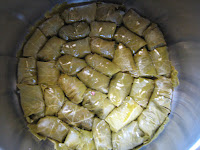 |
| Anna helps her mum |
However, apart from the elaborated dishes that have ornated the tables of the mighty and rich, what actually remains in the collective subconscious is the simple and often poor food, served on the tables of the humble people, dictated by seasonal ingredients and more often than not by what was affordable or available by foraging.
The women of the house, since cooking was a chore totally assigned to them, had to improvise from what little provisions they had in their pantry and provide a meal to satisfy the hunger of a usually extended family. A household which had stored in its cellar flour, olive oil, cheese and wine, was considered to be well-off and the rest of the staple foods were provided by the kitchen garden for vegetables and herbs and the nearby fields or forest for greens and various nuts.
Areas near the sea were also blessed with an abundance of fish and seafood and the mountainous people relied on hunting, mostly birds and hares. Wild boars have never become extinct even though they were hunted fiercely because they damaged farmer's crops.
 |
| Selling fish |
Farm animals were mostly raised for their products - milk, eggs, wool- and rarely consumed as meat,
A very popular traditional wedding song says " In my child's joy (=wedding), we slaughtered a rooster"! Imagine a feast, where the whole village was usually invited, with only one chicken as the centerpiece of the celebratory dinner!
This culture of self-sufficiency is gaining ground worldwide, especially in times of economic crisis such as these but I wouldn't imagine myself making an absolute 180⁰ u-turn and start doing everything from scratch. What I'd really like to do is to preserve those unfamiliar and unknown recipes, handed down from our grandmas, and maybe, just a little, taste the original flavors of a difficult but equally fascinating bygone time.
(The pictures for this post were taken from the alphabet book of my childhood)
unless they were very old or on festive days, such as Christmas or Easter. Even then they made the most of them and nothing was wasted.











